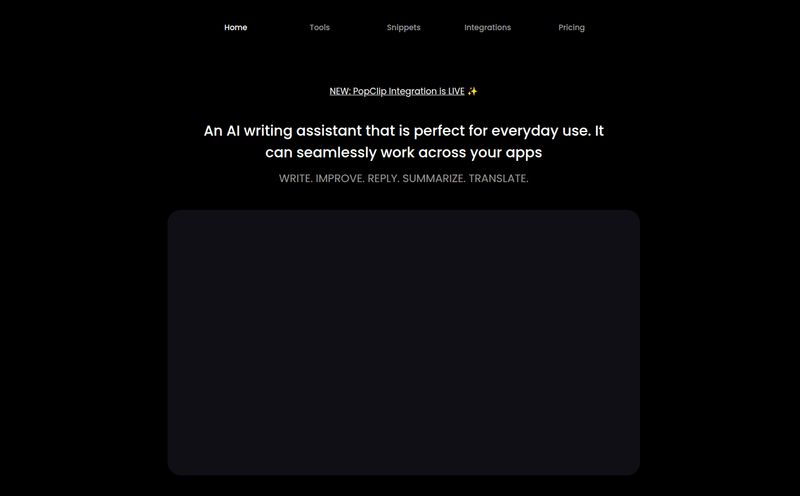If you're a developer or a product manager, the term "internationalization" probably makes you break out in a cold sweat. I know it does for me. I've spent more late nights than I care to admit wrestling with sprawling JSON files, chasing down missing keys, and trying to explain to a translator why `{{user_name}}` isn't a typo. It's a necessary evil if you want to go global, but man, it's a drag.
So when a tool pops up on my radar—especially one backed by the folks at Y Combinator—that claims to make internationalization (or i18n, for the cool kids) fast and easy, my ears perk up. The tool in question is Quetzal. The name itself is cool, evoking that colorful, exotic bird. But can it really help your app spread its wings across the globe without crashing and burning? I had to find out.
So, What Exactly is Quetzal?
In a nutshell, Quetzal is an internationalization platform built for modern web apps, specifically those using frameworks like Next.js and React. Instead of you manually managing translation files, Quetzal swoops in and automates a huge chunk of the process. It scans your code, finds user-facing text (strings), and uses AI to translate it all for you.
Think of it like this: it's less of a manual toolkit and more of an automated system. It aims to take the entire, messy workflow of finding text, sending it for translation, getting it back, and plugging it in, and condenses it into a single, smooth operation that happens every time you build your app.

Visit Quetzal
The Features That Actually Matter
Every SaaS tool has a features page longer than a CVS receipt. But what's the stuff that actually makes a difference in your day-to-day? After playing around with Quetzal, a few things really stood out to me.
AI-Powered Build-Time Translation
This is the secret sauce. Quetzal translates your content at build time. Why is this a big deal? It means the translations are baked right into the static files served to your users. This is a huge performance win compared to some solutions that fetch translations on the client side, which can slow down your site's initial load. On every build, it detects new or changed strings and automatically translates them. It’s a very set-it-and-forget-it kind of vibe, which I appreciate.
A Workflow Built for Developers
Honestly, this might be my favorite part. Quetzal comes with a VSCode extension. This is brilliant. It means you don’t have to constantly switch contexts between your code editor and some clunky web dashboard. You can manage things right where you're already working. This shows me the creators understand developer friction. They know that the less we have to leave our editor, the happier and more productive we are. It’s a small detail that makes a world of difference.
A Central Dashboard to Rule Them All
Okay, so I just praised not having to use a dashboard, but hear me out. For a high-level overview, a good dashboard is essential. Quetzal’s is clean and straightforward. You can see all your strings, check the status of translations across different languages (or 'locales'), and make manual tweaks if the AI gets something a bit… funky. Because let's face it, AI translation is amazing, but it's not always perfect. Especially with slang or brand-specific terminology. Having an easy way to override it is a must.
Let's Talk Money: The Quetzal Pricing Tiers
Alright, down to brass tacks. Is this going to cost an arm and a leg? Well, it depends. The pricing structure is pretty flexible, which is a good sign.
| Plan | Price | Who It's For |
|---|---|---|
| Starter | $0 / month | Indie hackers, personal projects, or testing the waters. You get one project and one translated language. Perfect for a proof of concept. |
| Business | $50 / month / locale | Small businesses and startups ready to expand. Supports up to 10 team members. The 'per locale' pricing means you need to be strategic about which markets you enter first. |
| Enterprise | Contact for pricing | Large-scale applications with a global user base. Unlimited everything and 24/7 support. The whole shebang. |
My take? The free Starter plan is genuinely useful, not just a crippled demo. You can build a fully functional, bilingual app on it. The Business plan is where it gets interesting. That $50/month/locale model can be very cost-effective if you're targeting just two or three key markets. But if your goal is to support 10+ languages, that cost will stack up quickly. You'll want to have a clear ROI for each new language you add.
The Good, The Bad, and The AI-Translated
No tool is perfect. After my time with Quetzal, here's my honest breakdown of where it shines and where you should be cautious.
What I loved was the sheer speed. The promise of "internationalize in minutes" is a bit bold, but it's not far from teh truth. For a new project, you can get up and running with multiple languages incredibly fast. The automatic string detection and the VSCode integration create a workflow that just feels… smooth. It removes so much of the traditional friction.
However, you have to go in with your eyes open. The biggest caveat is the reliance on AI for translation. For UI elements, buttons, and simple instructions, it's fantastic. But for marketing copy, nuanced articles, or anything that relies heavily on brand voice, you will need a human review. Think of the AI as a hyper-efficient junior translator. It gets you 90% of the way there, but a native speaker needs to do the final polish. Also, that per-locale pricing on the Business plan can be a double-edged sword. It's great for focused growth, but it can become a barrier to wide-scale experimentation if you're not careful with your budget.
So, Who Should Use Quetzal?
I see a very clear sweet spot for Quetzal. It's perfect for:
- Early-stage startups who want to validate international markets without hiring a localization team.
- Indie developers and side hustlers looking to give their project a global reach from day one.
- Agile teams using Next.js or React who prioritize development speed and want to integrate i18n directly into their CI/CD pipeline.
If you're a massive enterprise with a dedicated, 50-person localization team and a decade of established processes, this might not be for you (though their Enterprise plan might argue otherwise). But if you're part of a team that lives and breathes in VSCode and moves at a breakneck pace, Quetzal feels like it was built just for you.
Frequently Asked Questions
- Is Quetzal's AI translation accurate enough?
- For most UI text and common phrases, it's surprisingly good. However, for critical, brand-defining copy, we always recommend having a native speaker review and refine the AI's output. Use it as a powerful first draft, not the final word.
- What happens if I go over the limits on the free plan?
- The primary limitation on the Starter plan is potential rate limiting on the build-time translations. This means if you're pushing tons of builds in a short period, you might see delays. It's designed for the pace of a personal project, not a busy commercial team.
- Can I edit the translations Quetzal provides?
- Yes, absolutely. The dashboard allows you to easily find any string and manually override the AI translation for any language. This is crucial for maintaining quality and brand voice.
- Does Quetzal support languages other than the main 20+?
- The platform is constantly evolving. While they officially support a core set of languages, you'd likely need to talk to their team on a Business or Enterprise plan if you have more specific or less common language requirements.
- How hard is the initial setup?
- It's designed to be quick. You install their package, wrap your app component, and that's the core of it. Their documentation walks you through it, and for a standard Next.js app, you can be up and running in under 30 minutes.
Final Thoughts on Quetzal
Look, internationalization is still a complex problem. Quetzal doesn't magically make it disappear, but it does file down the sharpest edges. It transforms i18n from a multi-week, multi-team headache into a manageable, developer-centric task. It's a clever, modern solution that leverages AI and a smart workflow to solve a very real pain point.
For teams that want to move fast and break into new markets, Quetzal is a powerful ally. It's not a silver bullet, but it's a significant upgrade to the old way of doing things. It's definitely a tool I'll be keeping in my back pocket for future projects.
Reference and Sources
- Quetzal Official Website: https://www.quetzal-app.com/
- Y Combinator: https://www.ycombinator.com/
- Next.js Internationalization Documentation: https://nextjs.org/docs/pages/building-your-application/routing/internationalization



